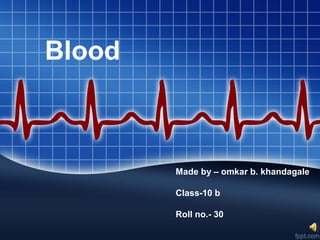
1854964 635072095191071250
- 1. Blood Made by – omkar b. khandagale Class-10 b Roll no.- 30
- 2. What is a blood? • Blood is a red coloured liquid which circulates in our body. Blood is red because it contains a red pigment called haemoglobin in its red cells. Blood is connective tissue. Blood consists of four things plasma,rbc,wbc and platelets. Thus, the main components of blood are
- 3. Red blood cells White blood cells platelets plasma
- 4. Plasma the liquid portion of blood. Plasma serves as a transport medium for delivering nutrients to the cells of the various organs of the body and for transporting waste products derived from cellular metabolism to the kidneys, liver, and lungs for excretion. It is also a transport system for blood cells, and it plays a critical role in maintaining normal blood pressure. Plasma helps to distribute heat throughout the body and to maintain homeostasis, or biological stability, including acid-base balance in the blood and body.
- 5. Plasma is derived when all the blood cells—red blood cells (erythrocytes), white blood cells (leukocytes), and platelets (thrombocytes)—are separated from whole blood. The remaining straw-coloured fluid is 90–92 percent water, but it contains critical solutes necessary for sustaining health and life. Important constituents include electrolytes such as sodium, potassium, chloride, bicarbonate, magnesium, and calcium. In addition, there are trace amounts of other substances, including amino acids, vitamins, organic acids, pigments, and enzymes. Hormones such as insulin, corticosteroids, and thyroxine are secreted into the blood by the endocrine system. Plasma concentrations of hormones must be carefully regulated for good health. Nitrogenous wastes (e.g., urea and creatinine) transported to the kidney for excretion increase markedly with renal failure.
- 6. Red blood cell also called erythrocyte, cellular component of blood, millions of which in the circulation of vertebrates give the blood its characteristic colour and carry oxygen from the lungs to the tissues. The mature human red blood cell is small, round, and biconcave; it appears dumbbell-shaped in profile. The cell is flexible and assumes a bell shape as it passes through extremely small blood vessels. It is covered with a membrane composed of lipids and proteins, lacks a nucleus, and contains hemoglobin—a red, iron-rich protein that binds oxygen.
- 7. The function of the red cell and its hemoglobin is to carry oxygen from the lungs or gills to all the body tissues and to carry carbondioxide, a waste product of metabolism, to the lungs, where it is excreted. In invertebrates, oxygen-carrying pigment is carried free in the plasma; its concentration in red cells in vertebrates, so that oxygen and carbon dioxide are exchanged as gases, is more efficient and represents an important evolutionary development. The mammalian red cell is further adapted by lacking a nucleus—the amount of oxygen required by the cell for its own metabolism is thus very low, and most oxygen carried can be freed into the tissues. The biconcave shape of the cell allows oxygen exchange at a constant rate over the largest possible area.
- 8. Platelets also called thrombocyte, colourless, nonnucleated blood component that is important in the formation of blood clots (coagulation). Platelets are found only in the blood of mammals. Platelets are formed when cytoplasmic fragments of megakaryocytes, which are very large cells in the
- 9. bone marrow, pinch off into the circulation as they age. They are stored in the spleen. Some evidence suggests platelets may also be produced or stored in the lungs, where megakaryocytes are frequently found. Platelets play an important role in the formation of a blood clot by aggregating to block a cut blood vessel and provide a surface on which strands of fibrin form an organized clot, by contracting to pull the fibrin strands together to make the clot firm and permanent, and, perhaps most important, by providing or mediating a series of clotting factors necessary to the formation of the clot. Platelets also store and transport several chemicals, including serotonin, epinephrine, histamine, and thromboxane; upon activation these molecules are released and initiate local blood vessel constriction, which facilitates clot formation.
- 10. White blood cell also called leukocyte or white corpuscle, a cellular component of the blood that lacks hemoglobin, has a nucleus, is capable of motility, and defends the body against infection and disease by ingesting foreign materials and cellular debris, by destroying infectious agents and cancer cells, or by producing antibodies. A healthy adult human has between 4,500 and 11,000 white blood cells per
- 11. cubic millimetre of blood. Fluctuations in white cell number occur during the day; lower values are obtained during rest and higher values during exercise. Intense physical exertion may cause the count to exceed 20,000 per cubic millimetre. White cell count also may increase in response to convulsions, strong emotional reactions, pain, pregnancy, labour, and certain disease states, such as infections and intoxications. Although white cells are found in the circulation, most occur outside the circulation, within tissues, where they fight infections; the few in the bloodstream are in transit from one site to another. As living cells, their survival depends on their continuous production of energy. The chemical pathways utilized
- 12. are more complex than those of red blood cells and are similar to those of other tissue cells. White cells, containing a nucleus and able to produce ribonucleic acid (RNA), can synthesize protein. White cells are highly differentiated for their specialized functions, and they do not undergo cell division (mitosis) in the bloodstream; however, some retain the capability of mitosis. On the basis of their appearance under a light microscope, white cells are grouped into three major classes—lymphocytes, granulocytes, and monocytes—each of which carries out somewhat different functions.
- 13. Thank you for watching this ppt THE END
